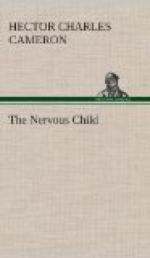We may pass from considering the imitativeness of the child to study a second and closely related quality, his suggestibility. His conception of himself as a separate individual, of his ego, only gradually emerges. It is profoundly modified by ideas derived from those around him. Because of his lack of acquired experience, there is in the child an extreme sensitiveness to impressions from outside. Take, for example, a matter that is sometimes one of great difficulty, the child’s likes and dislikes for food. Many mothers make complaint that there are innumerable articles of diet which the child will not take: that he will not drink milk, or that he will not eat fat, or meat, or vegetables, or milk puddings. There are people who believe that these peculiarities of taste correspond with idiosyncrasies of digestion, and that children instinctively turn from what would do them harm. I do not believe that there is much truth in this contention. If we watch an infant after weaning, at the time when his diet is gradually being enlarged to include more solid food, with new and varied flavours, we may see his attention arrested by the strange sensations. With solid or crisp food there may be a good deal of hesitation and fumbling before he sets himself to masticate and swallow. With the unaccustomed flavour of gravy or fruit juice there may be seen on his face a look of hesitation or surprise. In the stolid and placid child these manifestations are as a rule but little marked, and pleasurable sensations clearly predominate. With children of more nervous temperament it is clear that sensations of taste are much more acute. Even in earliest infancy, children have a way of proclaiming their nervous inheritance by the repugnance which they show to even trifling changes in the taste or composition of their food. We see the same sensitiveness in their behaviour to medicines. The mixture which one child will swallow without resentment, and almost eagerly, provokes every expression of disgust from another, or is even vomited at once. In piloting the child through this phase, during which he starts nervously at all unaccustomed sensations and flavours, the attitude of mother and nurse is of supreme importance. It is unwise to attempt force; it is equally unwise, by excessive coaxing, cajoling, and entreaty, to concentrate the child’s attention on the matter. If either is tried every meal is apt to become a signal for struggling and tears. The phase, whether it is short or long continued, must be accepted as in the natural order of things, and patience will see its end. The management of this symptom,—refusal of food and an apparently complete absence of desire for food,—which is almost the commonest neurosis of childhood, will be dealt with later. Here it is mentioned because I wish to emphasise that if too much is made of a passing hesitation over any one article of food, if it becomes the belief of the mother or nurse that a strong distaste is present, then if she is not careful




